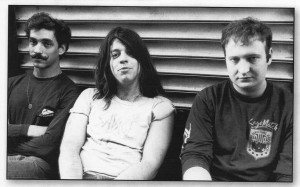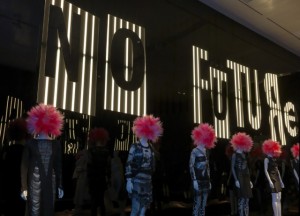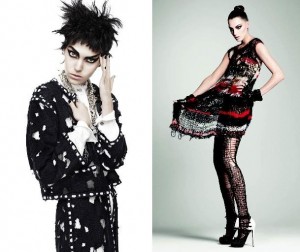The sound didn’t go away. If anything it became further entrenched with the underground in the ’80s, primarily with skateboard culture, and gained a sort of resurgence in the ’90s as an element of the alternative rock movement. In the ’80s, the sound was still a rejection of the times. The SST label gave us Husker Du. The original run of The Replacements was as bracing and caustic as what came before them. Black Flag created a cult-like following around themselves, but the only way you knew much about these bands at the time was if you knew the culture. This was our own secret enclave, and we really clung to that outsider elitism.
I Love Livin’ In The City – Fear
 The ’90s, on the other hand, saw groups like Nirvana blending punk with post-rock, arena rock, and whatever else stuck to the wall and that produced a new era for the sound. Green Day, who had released a couple independent albums prior to the breakthrough Dookie album now were quantifiable money makers. The Offspring did as well and didn’t even need to jump to a major label to do it. Their album Smash came out on Epitaph Records, which was run by Bad Religion’s Brett Gurewitz. We all know how this turned up, as this electrifying sound once again became a fashion, then a parody, and finally an afterthought. Major labels pounced on the indies in a feeding frenzy of signings that, more often than not, provided a wealth of poorly fitting cultures, bad sales, and acrimony. A whole new generation of musicians misread the remit. Rather than saying, “I want to be the weirdo and the irritant, and be heard as such,” they said, “I want to wear the funny hair and scream and get famous. The Offspring signed with Columbia. Green Day released a couple concept albums and had a Broadway hit based on one of them. There’s nothing inherently wrong with any of that, other than it tends to clash with a lot of the rhetoric that surrounds the form.
The ’90s, on the other hand, saw groups like Nirvana blending punk with post-rock, arena rock, and whatever else stuck to the wall and that produced a new era for the sound. Green Day, who had released a couple independent albums prior to the breakthrough Dookie album now were quantifiable money makers. The Offspring did as well and didn’t even need to jump to a major label to do it. Their album Smash came out on Epitaph Records, which was run by Bad Religion’s Brett Gurewitz. We all know how this turned up, as this electrifying sound once again became a fashion, then a parody, and finally an afterthought. Major labels pounced on the indies in a feeding frenzy of signings that, more often than not, provided a wealth of poorly fitting cultures, bad sales, and acrimony. A whole new generation of musicians misread the remit. Rather than saying, “I want to be the weirdo and the irritant, and be heard as such,” they said, “I want to wear the funny hair and scream and get famous. The Offspring signed with Columbia. Green Day released a couple concept albums and had a Broadway hit based on one of them. There’s nothing inherently wrong with any of that, other than it tends to clash with a lot of the rhetoric that surrounds the form.
Turn On The News – Husker Du
 Let’s not wade too deeply into the muck that is the language of “selling out.” Making a living is selling out. Choosing survival over defiant slow decay is selling out. Wanting to remain relevant is selling out, and so is growing up, and growing old. Ideological purity is a religion for the young and for dimwits who don’t realize their very existence contradicts their beliefs. A musician must sell, and thus must sell out, otherwise we’d all be in the park with our acoustic guitars giving it away for free. The ’90s didn’t kill punk, just as punk didn’t kill prog or soft rock; just as grunge and alt-rock didn’t kill hair metal. They all stepped a few inches to the side, out of direct view, back into their respective underground cultures, and that is not a bad thing.
Let’s not wade too deeply into the muck that is the language of “selling out.” Making a living is selling out. Choosing survival over defiant slow decay is selling out. Wanting to remain relevant is selling out, and so is growing up, and growing old. Ideological purity is a religion for the young and for dimwits who don’t realize their very existence contradicts their beliefs. A musician must sell, and thus must sell out, otherwise we’d all be in the park with our acoustic guitars giving it away for free. The ’90s didn’t kill punk, just as punk didn’t kill prog or soft rock; just as grunge and alt-rock didn’t kill hair metal. They all stepped a few inches to the side, out of direct view, back into their respective underground cultures, and that is not a bad thing.
The Eton Rifles – The Jam
Yet, I will retract one thought. Punk is not meant to be a celebrated classification. It was and is an expression of the weirdos, misfits, and outcasts who want to remain weirdos, misfits, and outcasts. If punk was a form of cultural vandalism for the sake of redeeming the spirit of rebellion, then its final undoing did not come from The Damned’s Captain Sensible and his Christmas record. It did not come from Blondie’s “The Tide Is High” or Belinda Carlisle leaving The Germs to form The Go-Gos. It wasn’t John (Rotten) Lydon’s Public Image Limited and it certainly wasn’t Iggy Pop’s ’80s pop. That would have been New York’s Metropolitan Museum of Art’s recent exhibit Punk: Chaos To Couture, where the whole load, the kit-and-caboodle, was lumped into a series of ripped jeans, piercings, and haircuts and summed up as a fashion choice. It is emblematic of our dreadful Twenty-Teens that we would reduce the whole damned thing down to what we wore, which is all we seem capable of anymore. The quality of our rebellion can be categorized by a handful of abused mannequins and a roll of toilet paper stolen from the head at CBGBs.
Disease – The Dictators
 It’s ignorant to gloss over the reality that this was Malcolm McLaren’s schtick to begin with, punk as fashion, but to focus so narrowly on an aesthetic choice from one band (later others) rather than the totality of it — that punk didn’t have a specific look outside of resolute informality — just means that the current batch of cultural gatekeepers is perfectly content to forget the “why” of the thing, (any substance or meaning, or just plain looking at the fact that this was a rejection of what these same gatekeepers are now), to be content with crippling inclusiveness. Everything is fashion. Everything is surface. It’s all show, and it’s all good. There is something disconcerting about fashion models and the glitterati who ooh and ahh over the twisted smiles and broken teeth of these icons, when they’ve never had a cavity in their lifetimes. And sitting in judgment of the stylization of “the street people” are folks who never have to actually set foot in an alleyway if they choose not to.
It’s ignorant to gloss over the reality that this was Malcolm McLaren’s schtick to begin with, punk as fashion, but to focus so narrowly on an aesthetic choice from one band (later others) rather than the totality of it — that punk didn’t have a specific look outside of resolute informality — just means that the current batch of cultural gatekeepers is perfectly content to forget the “why” of the thing, (any substance or meaning, or just plain looking at the fact that this was a rejection of what these same gatekeepers are now), to be content with crippling inclusiveness. Everything is fashion. Everything is surface. It’s all show, and it’s all good. There is something disconcerting about fashion models and the glitterati who ooh and ahh over the twisted smiles and broken teeth of these icons, when they’ve never had a cavity in their lifetimes. And sitting in judgment of the stylization of “the street people” are folks who never have to actually set foot in an alleyway if they choose not to.
Nothing wrong with art galleries. Nothing wrong with an assessment of our pop culture past. I do it all the time. But context is important, and framing the punk scene as couture seems like the boss admiring the worker’s brown bag sandwich, aspiring to its nutritional simplicity, it’s cost-benefit ratio, and compact portability. The worker says, “I like peanut butter and jelly and, frankly, it’s all I can afford.” Nonsense, says the boss, and immediately has the finest restaurant in town send over a $60 peanut butter and jelly sandwich…with crusts cut off.
California Uber Alles – The Dead Kennedys
And that is why we can’t even do rebellion right anymore. Mediocrity; bleats over beats. Shock not for effect, but because there’s nowhere left to go. Angst for the sake of looking enraged, but incapable of rage, because that requires a level of engagement we’re too cool to aspire to. Daddy issues (mommy issues?) capitulated as escapist fantasies versus primal scream therapy, and that same peanut butter theory where the rebels are also the bosses, railing against the system, claiming to disrupt the powers that be while alternately, transparently, proudly being aligned with the exact same powers.
We could use another punk revolution right now. Only we have too much invested in the status quo to even conceive of such risk.





Comments